|
|
||||
| home | ||||
| ELASTIK (KEBEL, PRINS, CIMOLINI). Mediator |
||||
The Stadskantoor Rotterdam (SKR) is, with its 65.000 m2, positioned in the very heart of the city and due to its primarily public function, being a service to the city's inhabitants, we were interested in providing a democratic and open concept. That is achieved by programming SKR into a flexible sharing- and exchange platform for the city of Rotterdam with the vision, which is entering future prospects. We were interested in carefully blending the existing programs, events and infrastructures towards the mixture of multiple urban events (working, living, shopping, consuming, recreating and educating).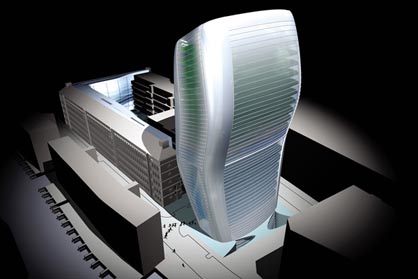 The scale-less exchange is happening on many levels; between the city's offices- and citizens, between the monumental-, the existing- and the new, between the surrounding services-, city hall- and SKR with its new addition, between individual- and public programs. But also between seasons in the environmentally smart design concept. The organization is programmed in a way that it can operate around the clock in order to activate new urbanity within the entire building block. The aim was to provide a transparent platform whereby buildings operate as an interface of the events and city-activities with their future policies. |
[06apr2002] | |||
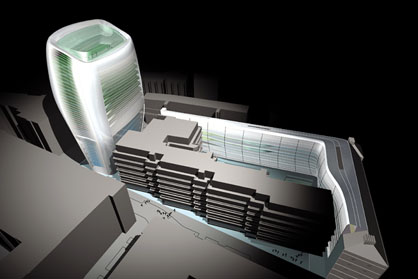 Our main focus there was the mix of the present and future users of SKR facilities. How to create a full support for the Rotterdammers and their visitors (workers, visitors and commuters, inhabitants, metro-businessmen and even telecommunication commuters) without interfering with their daily tasks is one of the most vital questions for the future development. Each of these user groups has developed their own living pattern following their own specific daily tasks - so the challenge there was how to facilitate them, but also make exchange areas where different users can meet. |
||||
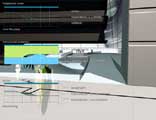 |
The conversion of the Stadstimmerhuis into the sharing platform for living- and working reflects this topic in a flexible manner. People from different usergroups meet in the ground floor lobby and are distributed to the different programmatic areas. The inhabitants share facilities like the small office - home offices (SoHo's) which provides an add-on workspace for the flexworkers and teleworkers living there. SOHO's are necessary due to the modern way of living where there is no clear separations between working and living in our daily routines and where more and more people work from their homes. SOHO's are positioned towards the areas, which are shared between SKR inhabitants and SKR workers. They meet in meeting spaces, support areas and recreation facilities. Recreation and shopping areas are also to provide publicness where SKR inhabitants meet with
Rotterdammers. |
Elastik
is an international brand for networking and designing architecture, urbanism and media with other disciplines, founded in 2001 by
Igor Kebel and Mika
Cimolini. Elastik members collaborate beyond geographical or institutional borders thus are people with an idea to challenge- and solve. Elastik’s key interest- and specialization is a development of scale-less platforms and products within quality time organization with specialists from other development fields.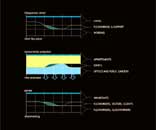 |
||
Following the strategy of integration the memory of Rotterdam's history is integrated into the new intervention, which is keeping both existing SKR buildings largely intact. New extensions and the existing SKR buildings are fully connected and seamlessly intertwined. There is no formal separation between the old and the new, they collide and melt together. New add-on tower thus takes the position of a site denominator where most of the SKR services are positioned but also the living room of the city on the top. Used as a wedding gallery at the two panoramic end floors are offering views across the city and a spectacular way to wed on the top of the city. There we have also put "City hall Museum" which is the other new program enriching the tower's identity in terms of publicness.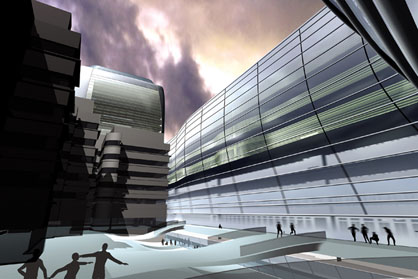
In order to prevent the overwhelming commercialization effect in the minus one level we have introduced programmatic fixation with art galleries and specialized shops. An improvement is the optimization of the distances between the different buildings, the SKR is in our proposal next to the city hall and the building on the Rodezand. The Stadstimmerhuis are so changing their administrative character into an open house for the city of Rotterdam. Specialized- and supply shops, tele-center and recreation areas are open to the city users as an add-on to the already existing restaurants, bars and shops in the area. Adaptive clustering of spaces is following the principle of flexible specialization where living- and working programs can be shifted at any time. Offices can be turned into appartments and appartments can become offices. This is made possible through the structural concept. Structurally fixed are only infrastructural servicing corridors which are channeling different users and shops. Offices and appartments are units along the infrastructure, they have similar size, height and depth. That makes them easily adaptable - today offices tomorrow living ! Offices or apartments and shops can be sub-divided into different-in-size cells, where the divisions can be solid or transparent. Light shafts are enabling further progression of any program in the depth of the Stadstimmerhuis. The design policy follows the strategy of openness, connectivity and environmental smartness. It starts with the reception landscape featuring the cross-connection between the entire surrounding including the waterfront area of the Haagseveer with the entrances for the shops and apartments. It is continued around the building as an underground connection between SKR and City hall at the Raamplein with the parking house underneath and the tower main entrance above. The Rodezand area is sustaining most of the reception functions of the SKR at the ground level. It facilitates also an opening for the underground parking. The drop- off area is located at the Zandstraat. Important entrance to the inner court is open to the more vibrant side of Rotterdam. The landscape of the inner court is gradually lowered towards the galleries and shops at the open level under the ground but it is also exchanging the level above with three wide and gently raising ramps. They are leading into the building before they are meeting again on the opposite side the Meent street and waterfront again. Environmental design and commodity concerns play a decisive role in the proposal. Using passive heating and cooling we are aiming towards lower running costs of the building and naturally ventilated spaces. This counts for the tower and for the extension of the Stadstimmerhuis. The volumes are smoothed in a way to minimize the external surfaces to built a compact volume and thus minimize the overall running costs. Hybrid geometry of the new extensions is oriented according to the sun trajectory for maximum insulation. Self-supporting surfaces lean towards the south and the floors are moving inwards to provide enough shade for the naturally ventilated interiors - no additional shading or cooling is needed. External facades (with their double skin) are proposed to cool the interior in summer and to keep the heat inside during the winter period. Self cooling and heating installations (air intakes) are to be placed in the elevation. In the landscape deep under the ground the building is connected to a warm- and cold water reservoir for the heating, ventilating and cooling. The landscape also covers the rain water collectors under the ground. Smart technologies are to be used on a principle of passive cooling and heating on demand. |
||||
| ELASTIK (KEBEL, PRINS, CIMOLINI). Mediator Public Award at the International idea competition Stadskantoor Rotterdam (City-Office Rotterdam) Project name: Mediator Author: Elastik (Igor Kebel, Marc Prins, Mika Cimolini) |
||||
| >
STADSKANTOOR > IN A BIT |
||||
laboratorio
|
||||